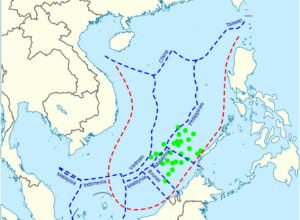Maybe this year

Despite the grand public fireworks displays, it was noticeably a somewhat different welcoming of the New Year. The traditional ritual of making merry elsewhere but having to be home before the stroke of midnight to imbibe the good luck of the new year, seems not to have been priority in this first Christmas holiday without the restrictions of the three-year COVID-19 pandemic. Forget the clanging of pans and the blowing of horns, the eating of grapes and round fruits and sticky native kakanins, and opening all the windows and doors, lighting all the lights to let the good vibes in! For the New Year, “happenings” with the family, not necessarily in traditional reunions at home, was the “in-thing.”
And so, my friend and his family (a group of 35 people) traveled together and toured major sites in Japan for nine days — Christmas to until after New Year’s Day. One couple went to Australia during Christmas week to be with the family. Pretty pictures of all the children and grandchildren! And so also were there many others who enjoyed the Christmas and New Year with family in the US or in Europe, or toured exotic places like Turkey and Greece, also with the whole family, including little children and babies. Air transportation officials estimated that around 140,000 outbound passengers traveled to local and international destinations during the last two weeks of December for the Christmas and New Year holidays (as per ABS-CBN News, Dec. 22, 2023).
The building of memories with loved ones can be a deep yearning for the good times — peaceful and safe. We have all, admittedly or in denial, been battered with three years of uncertainty about survival and even the fear of death. COVID-19 cases worldwide since its outbreak in 2020 up to Jan. 4, 2024 totaled 701,023,590, with 6,963,923 deaths (about 1%). The disease has affected almost every country and territory in the world, with the United States confirming around 16% of all global cases. In the Philippines, 3.7% or 4,137,482 of the population of 112,508,994 contracted COVID-19, with 1.6% (66,836) dying from the virus. The Philippines is #37 of 231 countries worst hit by COVID-19, in the statistics of www.worldometers.info/coronavirus.
What was depressing in 2023 was the observed stepped-up reinfection rate of COVID-19. Many people we know who had had the vaccination plus two boosters during the pandemic succumbed to a variation of the virus, suffering milder but still debilitating symptoms, but decidedly still infectious to others. Relaxed quarantine restrictions and undivulged conditions caused unexplained infection to others, and a second and third reinfection to the multiplied “carriers.”
“Every time you get infected, no matter the severity, there is always a chance that you can develop longer-term symptoms,” some American doctors say (New York Times, Aug. 17, 2023). Nature Medicine (fall issue, 2023) showed that people with two or more COVID infections were more than three times as likely to develop lung and heart issues, and over 1.5 times as likely to have a neurological disorder, including brain fog and strokes, than those who were only infected once.
Come to think of it, there were quite a few rather unexplained deaths of some friends and acquaintances, from supposed strokes and cardiac arrests, in 2023.
What now? What are we to do, and where are we to go? Travel and tour na lang with your family! Spend your money now — why save for an uncertain tomorrow?
Today, the peso savings deposit rate in Leading Bank X is an absurdly low interest rate of 0.0625% p.a. gross, or 0.05% net. The Philippine Statistics Authority (PSA) reports that the full-year average inflation rate in 2023 was 6%. As we learned in Economics 101, deflating the interest rate by the inflation rate gives us the real interest rate: .05% minus 6.0% gives -5.95%, a negative “carry” (rate), meaning, “we’ve been had!” We are really paying the bank to keep our money, protected of course by the Philippine Deposit Insurance Corp. (PDIC).
The PDIC provides a maximum deposit insurance coverage of P500,000 per depositor per bank. It covers all types of bank deposits in banks. For insurance purposes, all deposit accounts of a depositor in a closed bank maintained in the same right and capacity shall be added together. Joint accounts shall be insured separately from any individually owned deposit accounts.
As of end December 2021, 87.1 million accounts in 506 banks were covered by deposit insurance. Of this total number of accounts, 96.8% had balances not exceeding the maximum deposit insurance coverage. For the same period, total deposits in the Philippine banking system amounted to P16.2 trillion, of which 19.5% is covered by deposit insurance (pdic.gov.ph).
Note that peso Time Deposits (TDs) in tenors of 30, 60, 180 and 364 days are covered by the PDIC insurance of P500,000 per depositor per bank, but the minimum balance required by the bank per account is P5 million (so P4.5 million is not insured). Gross interest paid ranges from 5.275% (net 4.12%) to 6.025% (net 4.72%) declining as the tenor goes up (perhaps showing the banks’ pessimism for the longer term). Of course, the real interest will still be negative after deducting inflation, but that is just the way it is. Banks are complying with the Bangko Sentral ng Pilipinas (BSP) interest guiding rate ceiling of 6%. Trust your bank with your money.
But to be absolutely sure whom you should trust your money with, invest in government issuances of indebtedness — “risk-free” investments — like short-medium term Treasury Bills (T-Bills) offered at about 5.5% gross interest, FXTN/RTBs Retail Trade Bonds) or long term ROPs (Republic of the Philippines USD denominated bonds) with currently available offering maturities of e.g., 2031, 2045, and 2048, all available for purchase at a discounted rate to reflect present value, to assure the final yield to maturity (YTM) inclusive of compounded quarterly coupon interest. Perhaps the discounted price offered by government (approximately 70%-80% of face value) for the offered ROPs of 7-21 years tenor reflects its own prognosis of how the economy will still be struggling in at least the next two decades, and needing to “borrow” from the Filipino people to help the economy through.
The National Government’s (NG) total outstanding debt at the end of November 2023 amounted to P14.51 trillion. The debt stock increased by P27.92 billion or 0.19% month over month, primarily due to the net issuance of domestic securities. Of the total debt stock, 30.91% are from external sources while 69.09% are from domestic borrowings. For domestic debt, the end-November 2023 level of P10.02 trillion is P122.07 billion or 1.23% higher compared with the prior month due to the net issuance of government securities (dailyguardian.com.ph/national-government-debt, Jan. 6, 2024).
Yet the BSP announced that nominal GDP expanded by 5.9% in Q3 2023. We await the final real GDP growth figure for total 2023, which must be adjusted against inflation.
“The latest projections indicate that the inflation outlook has moderated over the policy horizon, although it will probably remain high notwithstanding the recent improvement in supply conditions. Upside risks are associated with the potential impact of higher transport charges, electricity rates, and international oil prices as well as higher-than-expected minimum wage adjustments in areas outside the National Capital Region. The BSP continues to deem it necessary to keep monetary policy settings sufficiently tight until sustained downtrend in inflation becomes fully evident and inflation expectations are firmly anchored,” the BSP said (bsp.gov.ph).
All this doesn’t look too good for 2024. Anxieties of the middle class for health and survival in the overhanging threat of COVID-19 are heightened by threatening realities of very limited material and financial opportunities in the country. Perhaps the horrifying fear is to sink lower in status and resources to poverty.
But “Trust in the Lord with all your heart, And lean not unto your own understanding.” (Proverbs 3:5)
With faith and hope, maybe this year things will be better for all.
Amelia H. C. Ylagan is a doctor of Business Administration from the University of the Philippines.




